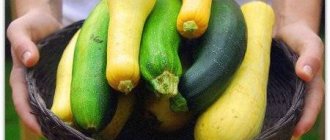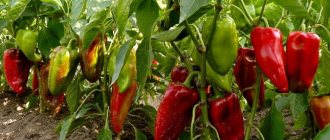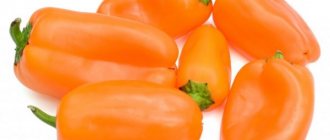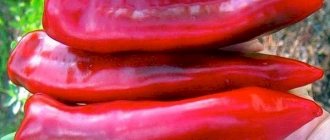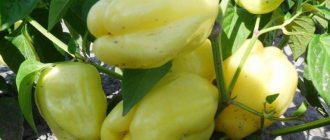Characteristics of the variety
| Parameter | Characteristic |
| Variety | Baby mammoth (Infantem mammoth) |
| Description of fruits | Large, trunk-shaped, with a rich red color at full maturity, durable glossy skin and thick walls. |
| Color | At the stage of technical maturity - green, at the stage of full maturity - dark red. |
| Fruit size | Up to 30 cm in length. |
| Wall thickness | 5-6 mm. |
| Taste of the fruit | Rich, pleasant. |
| Productivity | 6 kg/1 sq. m. |
| Maturation speed | 115-125 days. |
| Bush height | 50-55 cm. |
| Type of pollination (self-pollinating or not) | Self-pollinating. |
| Nestedness | 2-3 sockets (cameras). |
| Type of ovary formation | Single formation. |
| Transportability and keeping quality | At a high level. |
| Resistance to adverse conditions | Stable. |
| Resistance to diseases and pests | High. |
| Should I dive? | When planting in a common container - it is necessary. |
| Recommended growing regions | Central, Volgo-Vyatka, Central Black Sea Region, North Caucasus, Middle Volga, Lower Volga, Ural, West Siberian, East Siberian, Far Eastern, Northern, Northwestern. |
| Year of inclusion in the State Register of the Russian Federation | 2007 |
| Originator | Amateur seed grower Olga Postnikova. |
All kinds of peppers are needed, all kinds of peppers are important!
In our country, and in our family in particular, bell peppers are treated with deep respect and great love.
Crispy and juicy, with a subtle characteristic aroma and a sweetish taste - you can eat it straight from the garden. That’s why we plant a lot of it to stock it for future use. I want to say right away that we practically do not preserve peppers; we marinate only a small part of the harvest in strips with the addition of vegetable oil. We eat everything else fresh as part of summer dishes and freeze it. For many years, the main variety in our garden was the 'Marina' variety (red, orange and yellow). But gradually we moved away from it, the harvest became small, the taste was low. I can't say what this is connected with.
And now, every summer, newcomers appear in our greenhouse. I don’t choose many varieties at once to check; I prefer 3-4 pieces. This year they were 'Red Baron' F1, 'Bogatyr' and 'Nugget' F1. And, of course, 'California Miracle', a permanent variety.
1. 'Nugget' F1 In my opinion, it is good in everything. It grows beautifully and produces a lot of ovaries and fruits. Large, the wall is thick and the taste is simply excellent. There is only one correction: on the package it is orange-red, but in reality it is yellow. Keeping quality is average, but, compared to red varieties, it loses elasticity faster and begins to flabby. This is not surprising: peppercorns are very juicy.
2. ' Bogatyr' Passed the test in our greenhouse with a bang! The plant coped well with extreme heat (at +40°C in the shade throughout the summer) and at the same time pleased with a bountiful harvest. The pepper is slightly smaller in size than the previous variety, but thick-walled and of good taste.
3. 'Red Baron' F1 The size and ripening time correspond to the declared ones, but the shape is slightly different, it is not as glass-shaped as on the packet of seeds. I was pleased that the plant is compact, strong, and has a lot of fruits.
In addition, there was room for a new settler in the greenhouse. Two bushes of seedlings came to us from a neighbor.
'Mammoth' variety is unusual for its long and thin peppercorns; there are a lot of them on the bush. A good variety in all respects. However, in my personal opinion, the taste is inferior to previous varieties. It doesn't have enough juiciness or crunch).
In general, I am a supporter of the traditional way of growing bell peppers. If it's pepper, it's huge, with ribbed sides and a thick wall, red or, in extreme cases, yellow.
But next summer I want (purely for experimental purposes) to try the black variety.
Description of the variety
The history of the creation of the variety does not extend beyond the country. The pepper was bred on the personal farm of seed farmer Olga Postnikova. Despite the fact that the variety is included in the State Register, it is still considered folk.
In terms of maturity, Mammoth belongs to the mid-season group. Judging by the description of the variety by summer residents, the crop is easy to grow in open ground and in small greenhouses made of arches and tunnel-type film. According to the characteristics, the leaves of this pepper are medium in size, dark green in color and have a slightly wrinkled surface.
During formation and growth, the fruits are directed upward. Peppers have a bizarre trunk-shaped shape. The pulp of the vegetable is juicy, sweet and has a good taste. The use of fruits is universal. They can be used for preparing salads and snacks, stewed, frozen, and canned.
Description of fruits and characteristics of the variety
Baby mammoth is a typical representative of mid-season varieties; 115-125 days pass from the appearance of the first shoots to harvest, depending on the growing conditions. It stands out for its unpretentiousness and versatility.
Characteristics and description of the Mammoth variety:
- Bush. Powerful, closed type, up to 55 cm high. Covered with dark green wrinkled leaves.
- Fetus. It has an elongated shape, resembling a trunk, which is where the name comes from. They are located with their tops up, reaching a length of up to 30 cm and a weight of 180 to 250 g. At technical maturity they have a dark green color. The fruits at the stage of biological maturity look especially attractive, bright red in color with a smooth glossy surface (see photo). Valued for its rich taste, juicy, sweetish pulp up to 8-9 mm thick.
- Productivity and application. In greenhouse conditions, they harvest up to 6-7 kg/m2; for open ground, the figure is slightly lower. Due to its taste and good transportability, Mammoth is widely used for cultivation on farms. Pepper is suitable for fresh consumption, for cooking, canning and vegetable juices.
Unpretentiousness, resistance to diseases and unstable weather conditions have made the Mammoth sweet pepper variety popular among home garden owners.
Pros and cons of the variety
| Advantages | Flaws |
| Possibility of growing in open ground. | The fruits take a long time to acquire their final color. |
| Universal use in cooking. | |
| High yields regardless of the vagaries of the weather. | |
| Immunity to viral and fungal diseases. | |
| Simple agricultural technology. | |
| Excellent taste. | |
| Large fruit size. | |
| Long shelf life. | |
| Good transportability. | |
| Possibility to use seeds as opposed to f1 hybrids. |
Features of growing peppers, planting and care
Sowing seeds for seedlings is carried out 60-70 days before the intended planting of plants in a permanent place. The optimal temperature for seed germination is 26-28°C. Shoots appear in 12-15 days.
When two true leaves appear on the plants, they are transplanted into separate cups with a capacity of 0.3-0.5 liters.
Pepper does not like transplanting, so do not be surprised if after you have transplanted the seedlings into separate containers, they stop growing for a while. You can “smooth out” the stressful state a little by spraying the plants with Epin.
When to plant pepper seedlings in the ground
After the threat of return frosts has passed, the seedlings can be planted in a permanent location. Some people plant in open ground in May, while others only plant under covering material or under film; it all depends on the climatic conditions of your region.
When planting pepper seedlings in the ground for 1 sq. It is recommended to place up to 5 plants per meter of land, no more. Peppers are planted in the ground without being buried, but in exactly the same way as they grew in cups. Pepper plants, unlike tomatoes, very rarely produce lateral roots, so there is no point in deepening them.
Sweet peppers respond well to watering and fertilizing with complex mineral fertilizers. During the summer, 2-3 feedings are usually done.
Other interesting varieties of sweet peppers with photos, descriptions and reviews from gardeners in our Pepper Catalog. Enjoy watching.
If you grew Mammoth pepper, please write whether you liked it or not. What was the yield under your climatic conditions? How do you rate the disease resistance of this pepper? If possible, attach a photo of the entire bush or individual fruits you grew to your comment. Thank you!
Your reviews of the Mammoth pepper and additions to the description will help you evaluate this hybrid more objectively and decide whether to plant it or not.
Tips for growing the Mammoth variety
Growing Mammoth pepper is not difficult, since the vegetable is intended for open ground, which means it easily tolerates temperature fluctuations and other unfavorable factors. Peppers are not very fond of picking; this procedure can temporarily stop growth. Those for whom it is important to get a harvest without delay can sow the seeds immediately in separate cups or peat tablets.
When to sow Mammoth pepper seedlings
Sowing dates vary greatly depending on the growing region. Seedlings are transplanted into open ground at the age of 2 months. This is what you need to start from when calculating the planting date. In warm regions, peppers are sown as seedlings at the end of February, and at the end of April they are moved to the garden bed.
Gardeners in Siberia and the Far East have to sow pepper at the end of March or early April in order to plant the bushes in open ground in the last days of May. For the Moscow region, the terms are averaged. If the pepper is planted in a greenhouse, seedlings begin to be prepared 1.5-2 weeks earlier.
How many days does it take for Mammoth pepper seeds to germinate?
Normally, pepper seeds germinate in 10-12 days. Shoots will appear even faster if you first germinate the seed or at least soak it for a couple of hours in warm water. The older the seeds, the harder their shell. It may take 3 weeks for these seeds to hatch. The germination process is also affected by the temperature in the room. The indicator should be at +25-27° C. In a cooler room, the appearance of sprouts slows down.
When and at what distance to plant Mammoth pepper in the ground
Seedlings are transplanted into the ground when night temperatures rise to +15-17° C. You need to focus not only on the climatic features of the region, but also on the weather in the current season. Spring can be either early or late. You can plant peppers in the greenhouse early. If there is a threat of night frosts, the seedlings are covered with film.
Warm beds are perfect for culture. The principle of their design is as follows: as a result of decay of organic matter, the soil becomes a heating pad for planted cultivated plants. Since the Mammoth pepper bushes are quite compact, an interval of 40 cm is left between them. Plants should be planted at the same depth at which they were in the pot.
Ripening period
The full growing season of pepper lasts from 115 to 125 days. Depending on the area, the harvest is harvested in July or in the first half of August. If the weather turns bad, you can pick the fruits from the bush at the stage of technical maturity; they will ripen at home. Outside, peppers can take a long time to gain color if it becomes cloudy and cool.
Watering
Regular watering is one of the basics of care. The pepper is watered with exclusively warm water, which is collected in barrels in advance. It is important for gardeners to know that the crop does not tolerate moisture on the stems and leaves; water the pepper strictly at the root. On average, watering is carried out every 3-4 days, increasing the amount of water as the bushes grow. In hot weather, the soil is moistened every other day or daily.
What and when to feed
The first fertilizing after transplanting to the garden bed should be carried out 1.5-2 weeks later. Fertilizers are then applied before flowering. The third time you need to feed the pepper is in the active fruiting phase. Since the variety does not have a large bush height, the plants will have enough mineral fertilizers.
Initially, it may be urea or ammonium nitrate. The second time the pepper is fed with potassium sulfate and superphosphate. The third top dressing may consist of wood ash dissolved in water. Application rates must be strictly observed. An overdose of fertilizers will harm the plants.
Is it necessary to form a Mammoth pepper bush?
Typically, bush formation is used when growing tall varieties of peppers. Pinching has a positive effect on yield. In this case, you can collect 1.5 times more fruits from one plant, since the plant will redirect the main forces to the formation and maturation of the ovaries. Since Baby Mammoth grows short, there is no need to form a bush.
Diseases and pests
Mammoth pepper is resistant to most typical diseases. Prevention of fungal diseases is compliance with agricultural technology and crop rotation rules. If plaque and spots appear on the leaves, the bushes are treated with fungicides.
Among the pests that can parasitize the crop are thrips, aphids, Colorado potato beetles, and cutworms. To reduce the insect population, modern insecticides are used. At the initial stage of infection, folk remedies (infusion of onion or garlic, decoction of wormwood) will help.
Features of cultivation
They use the seedling method of cultivation, even in greenhouse cultivation. The ripening time for Mammoth pepper seedlings is about two months. This must be taken into account; seedlings should be sown two months before planting in the ground. Planting times will vary greatly among areas with different climates. In warm areas it can be planted as early as the end of April, that is, seedlings should be sown at the end of February. For cold areas, where cultivation is possible only from the end of May in greenhouses, it is better to sow it at the end of March - beginning of April.
The best temperature for germinating pepper seeds is from 22 to 26 degrees. The period of emergence of seedlings is about two weeks. The optimal pot size for growing peppers is at least 0.3 liters. Sprouted seeds are planted in pots when they have two strong leaves. When growing seedlings, fertilizing is not recommended, however, after transplanting into pots, you can spray the seedlings with biostimulant preparations to speed up establishment.
It is recommended that Mammoth pepper seedlings be planted in the ground so that the distance between neighboring plants is at least 40 cm. It is not recommended to be adjacent to tall crops such as tomatoes. But peppers get along well next to eggplants. Moreover, the growing conditions are very similar. There is no need to plant deep; it is enough to place the pots of peppers level with the ground.
Inflorescences begin to form a month after planting. During this time, it is advisable to keep the greenhouse or greenhouse open so that insects can pollinate them. Also, when setting inflorescences, you can spray the plants with KANU to increase productivity and make the first fertilizing with complex fertilizers. The second fertilizing is done at the beginning of crop ripening. You can do intermediate fertilizing when the plants are affected by diseases, they need to recover, and also spray against pests and pepper diseases.
Diseases, pests
Mammoth sweet pepper resists pests and diseases quite well, especially with proper care. However, they exist, you need to know about them.
End rot
The disease is non-infectious and is caused by a lack of watering, high temperature and calcium in the soil. It is expressed as rotting, drying out of the fruit, starting from the tips, usually in the early phase of ripening due to the outflow of moisture to the leaves. May be caused by excess nitrogen fertilizers. Control measures include timely watering and fertilizing with calcium nitrate.
Eden
Seedling disease, non-infectious. It is expressed as the appearance of rashes on the leaves on the underside. Caused by the outflow of moisture from the leaves to the roots. Countermeasures include planting seedlings in the ground.
Gray rot
A fungal disease, expressed as a gray coating on the fruits, their rotting. Occurs due to excess humidity at temperatures not exceeding 16 degrees. Control measures: ventilation of greenhouses, increasing the temperature, removing affected plants and their parts. Often appears under film covers.
Anthracnose
Spotty fungal infection of leaves, fruits and stems. For control, crop rotation, the use of high-quality seeds, and the removal of weeds and plant residues are practiced. Fungicides for combating fungal diseases of peppers are ineffective, so they should not be used.
Tobacco mosaic
The infection is viral, affecting fruits and leaves with a characteristic pattern. The only way to control is to remove affected plants and perennial weeds on which the virus overwinters. Crop rotation also helps. There are no effective drugs against viruses.
Withering
The disease is of a viral nature, manifests itself as drying of the plant after sowing in the ground, as well as at the stage of harvest ripening. You can fight it by treating the seeds before sowing with a solution of potassium permanganate, using crop rotation, and carefully removing plant debris in the fall.
scoop
Caterpillar, pest of peppers. Green in color, the butterfly has a thick body and dark-colored wings. It makes holes in the fruits, causing them to rot. The best way to fight is to collect the caterpillars by hand.
Aphid
Affects adult plants. Ants contribute to the spread of aphids. To combat, you can use crop rotation, treat the soil and leaves of plants with insecticides. It will also be useful to treat the soil with preparations before autumn plowing, as well as freezing greenhouses in winter.
Advantages and disadvantages
The main advantages of the Mammoth pepper are its good yield, fleshy, juicy peppers, which are used for canning, chew well and are suitable for salads. The variety is excellent for growing indoors. It can also be grown in greenhouses, and the greenhouse film itself does not need to be removed even in summer, if the air temperature is below 30 degrees. Pepper tolerates heat well, but cold will be destructive for it. Plants do not require pinching, which minimizes complex care and the risk of damage.
Disadvantages include susceptibility to diseases such as end rot. The baby mammoth needs to be watered well and a lot. Its second feature is the requirements for soil acidity and aeration. It is advisable to grow it in light soils with neutral acidity. It tolerates acidified ones quite poorly.
Analogs
Varieties can be similar in different respects - method of cultivation, ripening time, yield, appearance of fruits. The list of mid-season varieties for open ground with red peppers includes:
- California miracle;
- Bogatyr;
- Love F1;
- Martin.
If you compare the full characteristics of these varieties, there will be differences between them. For example, the size and type of bush and productivity indicators may differ.
The Mammoth pepper variety is in demand because of its unpretentiousness, abundant fruiting, and tasty and attractive-looking fruits. The bushes withstand temperature fluctuations and other negative factors. The pepper does not need to be shaped or tied up. Since this is a varietal variety and not a hybrid, you can use your own seeds for propagation.
Diseases and pests
The best way to prevent diseases is to carry out preventive treatments with fungicides. The main diseases of pepper are:
- Alternaria blight;
- bacteriosis;
- verticillium wilt;
- viral diseases.
To control pests, insecticides are used to reduce insect populations. The most dangerous for pepper are:
- Colorado beetle;
- tomato scoop;
- aphid;
- thrips



